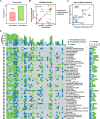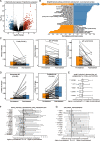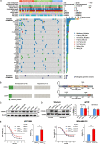Genomic and transcriptomic analysis of breast cancer identifies novel signatures associated with response to neoadjuvant chemotherapy
- PMID: 38217005
- PMCID: PMC10787499
- DOI: 10.1186/s13073-024-01286-8
Genomic and transcriptomic analysis of breast cancer identifies novel signatures associated with response to neoadjuvant chemotherapy
Abstract
Background: Neoadjuvant chemotherapy (NAC) has become a standard treatment strategy for breast cancer (BC). However, owing to the high heterogeneity of these tumors, it is unclear which patient population most likely benefit from NAC. Multi-omics offer an improved approach to uncovering genomic and transcriptomic changes before and after NAC in BC and to identifying molecular features associated with NAC sensitivity.
Methods: We performed whole-exome and RNA sequencing on 233 samples (including matched pre- and post-treatment tumors) from 50 BC patients with rigorously defined responses to NAC and analyzed changes in the multi-omics landscape. Molecular features associated with NAC response were identified and validated in a larger internal, and two external validation cohorts, as well as in vitro experiments.
Results: The most frequently altered genes were TP53, TTN, and MUC16 in both pre- and post-treatment tumors. In comparison with pre-treatment tumors, there was a significant decrease in C > A transversion mutations in post-treatment tumors (P = 0.020). NAC significantly decreased the mutation rate (P = 0.006) of the DNA repair pathway and gene expression levels (FDR = 0.007) in this pathway. NAC also significantly changed the expression level of immune checkpoint genes and the abundance of tumor-infiltrating immune and stroma cells, including B cells, activated dendritic cells, γδT cells, M2 macrophages and endothelial cells. Furthermore, there was a higher rate of C > T substitutions in NAC nonresponsive tumors than responsive ones, especially when the substitution site was flanked by C and G. Importantly, there was a unique amplified region at 8p11.23 (containing ADGRA2 and ADRB3) and a deleted region at 3p13 (harboring FOXP1) in NAC nonresponsive and responsive tumors, respectively. Particularly, the CDKAL1 missense variant P409L (p.Pro409Leu, c.1226C > T) decreased BC cell sensitivity to docetaxel, and ADGRA2 or ADRB3 gene amplifications were associated with worse NAC response and poor prognosis in BC patients.
Conclusions: Our study has revealed genomic and transcriptomic landscape changes following NAC in BC, and identified novel biomarkers (CDKAL1P409L, ADGRA2 and ADRB3) underlying chemotherapy resistance and poor prognosis, which could guide the development of personalized treatments for BC.
Keywords: Breast cancer; Genomic; Neoadjuvant chemotherapy; Pathological response; Prognosis; Transcriptomic.
© 2024. The Author(s).
Conflict of interest statement
The authors declare that they have no competing interests.
Figures






References
-
- Pusztai L, Foldi J, Dhawan A, DiGiovanna MP, Mamounas EP. Changing frameworks in treatment sequencing of triple-negative and HER2-positive, early-stage breast cancers. Lancet Oncol. 2019;20(7):e390–390e396. 10.1016/S1470-2045(19)30158-5. - PubMed
Publication types
MeSH terms
Substances
Grants and funding
LinkOut - more resources
Full Text Sources
Medical
Research Materials
Miscellaneous

